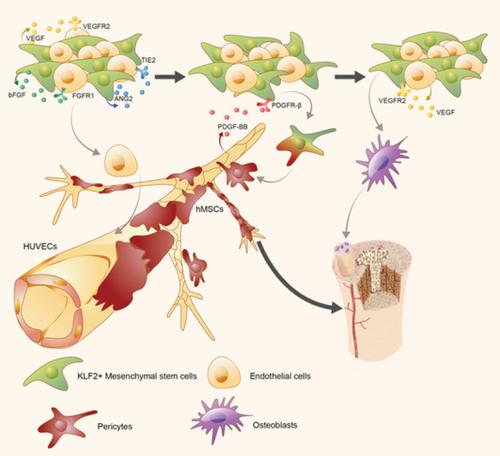当前位置:
X-MOL 学术
›
STEM CELLS
›
论文详情
Our official English website, www.x-mol.net, welcomes your feedback! (Note: you will need to create a separate account there.)
KLF2+ stemness maintains human mesenchymal stem cells in bone regeneration
STEM CELLS ( IF 5.2 ) Pub Date : 2019-12-14 , DOI: 10.1002/stem.3120 Ying Zhou 1 , Chao Liu 1 , Jianxiang He 1 , Lingqing Dong 1, 2 , Huiyong Zhu 3 , Bin Zhang 4 , Xiaoxia Feng 1 , Wenjian Weng 2 , Kui Cheng 2 , Mengfei Yu 1, 3 , Huiming Wang 1, 3
STEM CELLS ( IF 5.2 ) Pub Date : 2019-12-14 , DOI: 10.1002/stem.3120 Ying Zhou 1 , Chao Liu 1 , Jianxiang He 1 , Lingqing Dong 1, 2 , Huiyong Zhu 3 , Bin Zhang 4 , Xiaoxia Feng 1 , Wenjian Weng 2 , Kui Cheng 2 , Mengfei Yu 1, 3 , Huiming Wang 1, 3
Affiliation

|
Mesenchymal stem cells (MSCs), which are undifferentiated stem cells with the property of stemness and the potential to differentiate into multiple lineages, including osteoblasts, have attracted a great deal of attention in bone tissue engineering. Consistent with the heterogeneity of MSCs, various surface markers have been used. However, it is still unclear which markers of MSCs are best for cell amplification in vitro and later bone regeneration in vivo. Krüppel‐like Factor 2 (KLF2) is an important indicator of the stemness of human MSCs (hMSCs) and as early vascularization is also critical for bone regeneration, we used KLF2 as a novel in vitro marker for MSCs and investigated the angiogenesis and osteogenesis between KLF2+ MSCs and endothelial cells (ECs). We found a synergistic interaction between hMSCs and human umbilical vein ECs (HUVECs) in that KLF2+ stemness‐maintained hMSCs initially promoted the angiogenesis of HUVECs, which in turn more efficiently stimulated the osteogenesis of hMSCs. In fact, KLF2+ hMSCs secreted angiogenic factors initially, with some of the cells then differentiating into pericytes through the PDGF‐BB/PDGFR‐β signaling pathway, which improved blood vessel formation. The matured HUVECs in turn synergistically enhanced the osteogenesis of KLF2+ hMSCs through upregulated vascular endothelial growth factor. A three‐dimensional coculture model using cell‐laden gelatin methacrylate (GelMA) hydrogel further confirmed these results. This study provides insight into the stemness‐directed synergistic interaction between hMSCs and HUVECs, and our results will have a profound impact on further strategies involving the application of KLF2+ hMSC/HUVEC‐laden GelMA hydrogel in vascular network bioengineering and bone regeneration.
中文翻译:

KLF2+ 干性在骨再生中维持人类间充质干细胞
间充质干细胞(MSCs)是一种未分化的干细胞,具有干性和分化成包括成骨细胞在内的多种谱系的潜力,在骨组织工程中引起了极大的关注。与 MSC 的异质性一致,已使用各种表面标记。然而,目前尚不清楚哪些 MSCs 标志物最适合体外细胞扩增和随后的体内骨再生。Krüppel 样因子 2 (KLF2) 是人类 MSCs (hMSCs) 干性的重要指标,由于早期血管化对骨再生也至关重要,我们使用 KLF2 作为 MSCs 的新型体外标志物,并研究了 MSCs 之间的血管生成和成骨KLF2+ MSCs 和内皮细胞 (ECs)。我们发现 hMSCs 和人脐静脉 ECs (HUVECs) 之间存在协同相互作用,KLF2+ 干性维持的 hMSCs 最初促进了 HUVECs 的血管生成,进而更有效地刺激了 hMSCs 的成骨。事实上,KLF2+ hMSCs 最初会分泌血管生成因子,然后一些细胞通过 PDGF-BB/PDGFR-β 信号通路分化为周细胞,从而改善血管形成。成熟的 HUVECs 反过来通过上调血管内皮生长因子协同增强 KLF2+ hMSCs 的成骨。使用载有细胞的甲基丙烯酸明胶 (GelMA) 水凝胶的三维共培养模型进一步证实了这些结果。这项研究提供了对 hMSCs 和 HUVECs 之间干性导向的协同相互作用的见解,
更新日期:2019-12-14
中文翻译:

KLF2+ 干性在骨再生中维持人类间充质干细胞
间充质干细胞(MSCs)是一种未分化的干细胞,具有干性和分化成包括成骨细胞在内的多种谱系的潜力,在骨组织工程中引起了极大的关注。与 MSC 的异质性一致,已使用各种表面标记。然而,目前尚不清楚哪些 MSCs 标志物最适合体外细胞扩增和随后的体内骨再生。Krüppel 样因子 2 (KLF2) 是人类 MSCs (hMSCs) 干性的重要指标,由于早期血管化对骨再生也至关重要,我们使用 KLF2 作为 MSCs 的新型体外标志物,并研究了 MSCs 之间的血管生成和成骨KLF2+ MSCs 和内皮细胞 (ECs)。我们发现 hMSCs 和人脐静脉 ECs (HUVECs) 之间存在协同相互作用,KLF2+ 干性维持的 hMSCs 最初促进了 HUVECs 的血管生成,进而更有效地刺激了 hMSCs 的成骨。事实上,KLF2+ hMSCs 最初会分泌血管生成因子,然后一些细胞通过 PDGF-BB/PDGFR-β 信号通路分化为周细胞,从而改善血管形成。成熟的 HUVECs 反过来通过上调血管内皮生长因子协同增强 KLF2+ hMSCs 的成骨。使用载有细胞的甲基丙烯酸明胶 (GelMA) 水凝胶的三维共培养模型进一步证实了这些结果。这项研究提供了对 hMSCs 和 HUVECs 之间干性导向的协同相互作用的见解,


























 京公网安备 11010802027423号
京公网安备 11010802027423号